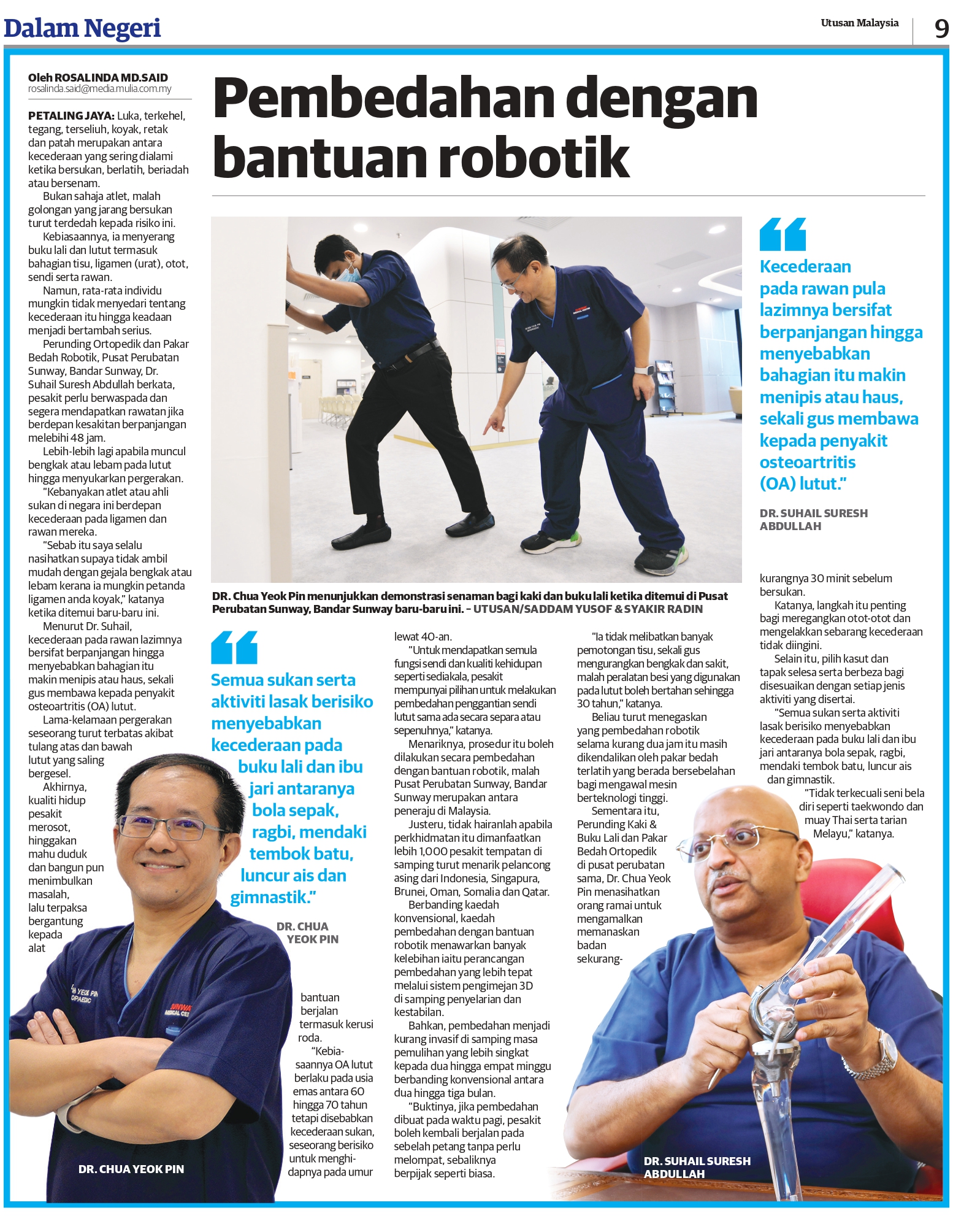Robotic-Assisted Surgery in Orthopaedic
28 July 2024

PETALING JAYA: Sprains, strains, tears, fractures, and breaks are among the common injuries experienced during sports, training, leisure activities, or exercise. Not only athletes but also those who rarely engage in sports are at risk of these injuries. Typically, they affect the ankles and knees, as well as tissues, ligaments, muscles, joints, and cartilage. However, many individuals may not be aware of these injuries until the condition worsens.
 Dr. Suhail Suresh Abdullah, Consultant Orthopaedic and Robotic Surgeon at Sunway Medical Centre, Sunway City, advises patients to be cautious and seek treatment immediately if they experience prolonged pain lasting more than 48 hours, especially when swelling or bruising appears on the knee, making movement difficult.
Dr. Suhail Suresh Abdullah, Consultant Orthopaedic and Robotic Surgeon at Sunway Medical Centre, Sunway City, advises patients to be cautious and seek treatment immediately if they experience prolonged pain lasting more than 48 hours, especially when swelling or bruising appears on the knee, making movement difficult.
"Most athletes or sports enthusiasts in the country face injuries to their ligaments and cartilage. This is why I often advise not to take symptoms like swelling or bruising lightly, as they may indicate a torn ligament," he stated during a recent interview.
According to Dr. Suhail, cartilage injuries often have long-lasting effects, leading to thinning or wear and tear of the affected area, ultimately resulting in knee osteoarthritis (OA). Over time, a person's movement may be restricted due to the friction between the upper and lower knee bones. Eventually, the patient's quality of life deteriorates to the point where even sitting down or standing becomes problematic, requiring the use of walking aids, including wheelchairs.
"Typically, knee OA occurs in older adults aged between 60 and 70, but due to sports injuries, individuals may be at risk of developing it in their late 40s. To regain joint function and quality of life, patients have the option of undergoing knee joint replacement surgery, either partially or completely," he explained.
Interestingly, this procedure can be performed using robotic assistance, and Sunway Medical Centre is one of the leaders in Malaysia in this field. It’s no surprise that over 1,000 local patients have benefited from this service, which has also attracted international patients from countries like Indonesia, Singapore, Brunei, Oman, Somalia, and Qatar.
 Compared to conventional methods, robotic-assisted surgery offers numerous advantages, such as more accurate surgical planning through a 3D imaging system, along with better coordination and stability. Furthermore, the surgery is less invasive, with a shorter recovery time of two to four weeks, as opposed to the two to three months required for traditional methods.
Compared to conventional methods, robotic-assisted surgery offers numerous advantages, such as more accurate surgical planning through a 3D imaging system, along with better coordination and stability. Furthermore, the surgery is less invasive, with a shorter recovery time of two to four weeks, as opposed to the two to three months required for traditional methods.
"The proof is that if surgery is performed in the morning, patients can be back on their feet by the afternoon without needing to hop; they can walk as usual. It involves less tissue cutting, thereby reducing swelling and pain, and the metal implants used in the knee can last up to 30 years," he added.
He also emphasised that the robotic surgery, which lasts less than two hours, is still conducted by trained surgeons who are present to control the advanced machinery.
Meanwhile, Dr. Chua Yeok Pin, Consultant Foot and Ankle and Orthopaedic Surgeon at the same medical centre, advises the public to warm up for at least 30 minutes before engaging in sports. He states that this step is crucial for stretching the muscles and preventing unwanted injuries.
Additionally, he recommends choosing comfortable shoes and soles that are suitable for each type of activity. "All sports and strenuous activities carry a risk of injury to the ankle and toes, including football, rugby, rock climbing, ice skating, and gymnastics. Martial arts such as taekwondo and muay Thai, as well as Malay dance, are also not exempt," he noted.
Source: Utusan Malaysia
后退




